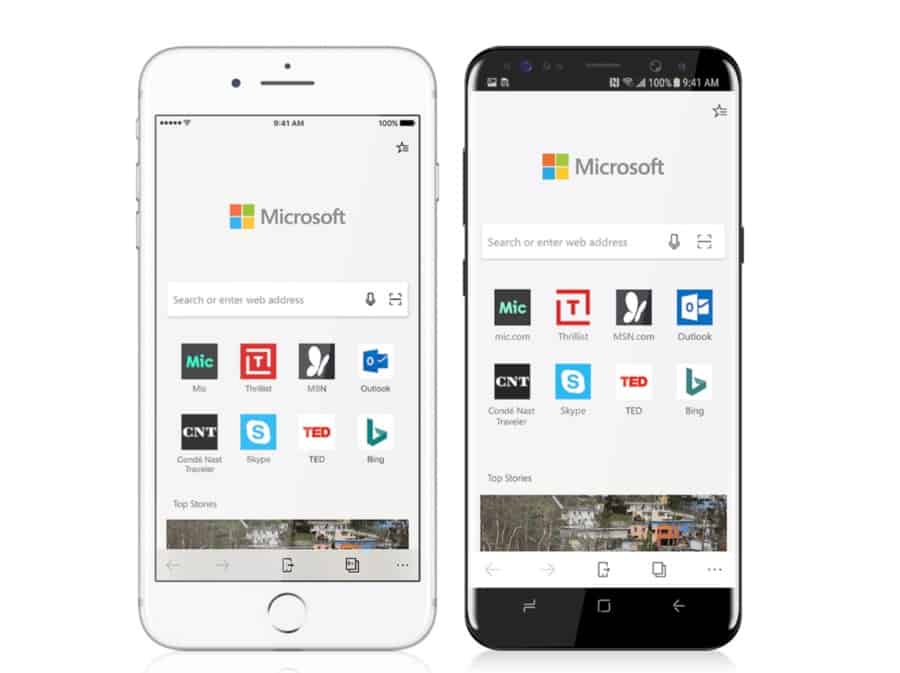
Above: Microsoft announced preview versions of Edge for iOS and Android in late 2017.
BitDepth#1180 for January 17, 2018
The browser wars have been going on since the World Wide Web was opened up to the world. The first web browser was Mosaic, basically a proof of concept app created to show how HTML code could be turned into a readable page.
It was soon overtaken by a commercial project, Netscape Navigator, which began the process of turning a web browser into an ecosystem of code interpretation, generation and communication.
But that wasn’t really a war, it was the rapid evolution of the concept of a web browser. The first browser war didn’t formally begin until Microsoft introduced Internet Explorer (IE) in 1995, a product that was simply a rewrite of the Mosaic browser at the start.
Netscape started with 80 percent of the browser market, but Microsoft had 90 percent of the operating system market, and the decisive blow came when IE came bundled with Windows, a move that led to years of cross-examination in the court system.
This battle continued for years, and in those early days of the Internet, code wasn’t sufficiently formalised and universal and wild divergences led web designers to create pages optimised and labeled to look best on either Netscape or IE. Yes that was a thing, back in the day.
This all seems silly today, in an age in which the World Wide Web Consortium (W3C) has successfully created code interpretation standards which all browsers are supposed to honour.
The Mozilla Foundation and its product, Firefox are the descendants of Netscape, which open-sourced its code when it finally collapsed.
In December, Microsoft announced that Edge, the web browser it created to replace IE, would drop its spanking new rendering engine components, Chakra and EdgeHTML, for Blink the Chromium based engine used by Google Chrome and other browsers.
This reduces to three the widely used rendering engines for the web that users can choose from, Mozilla’s Gecko, Google’s Blink and Apple’s WebKit.
In December, Microsoft announced that Edge, the web browser it created to replace IE, will switch to Blink, the Chromium based engine used by Google Chrome and other browsers.
Blink and Webkit share development genes, and WebKit’s outsized reach is the result of Apple’s insistence on that browser engine for any web browser on its mobile devices.
It also makes it easier for Microsoft to create versions of Edge for earlier versions of Windows and other platforms.
Edge did not run on Windows 7 or earlier, leaving those users with either the choice of either the publicly disparaged IE or another browser
In an era in which browser wars are largely a historical footnote, Microsoft’s problems with Edge turn out to be largely of its own creation.
In 2016, Microsoft held to its promise to drop support for earlier versions of IE, which, to be frank, were an annoyance to web developers because of long-term, spotty support for developing web technologies and coding systems.
A startling 22 percent of IE users simply switched browsers, according to NetTally. In 2017, 35 percent of those who remained also switched.
On December 2018, according to StatCounter, Chrome had 62.3 percent of overall browser share compared to Edge’s two percent.
The change in engine is a straightforward business decision for Microsoft, but it creates a world in which one company has stunning majority presence in the business of deciding what the Internet looks like in a browser window.
The last time that happened, it triggered antitrust investigations into the business practices of…pause for an ironic beat here…Microsoft.
It must have been clear to Microsoft that a browser with less marketshare than the one built into Android wasn’t worth the effort that an independent web rendering engine demands.
What the Internet community now faces is an environment with less choice and the prospect of Google, with its commanding marketshare, defining the way the web looks right down to every div tag displayed on every computer or mobile device.
In some ways, it’s an ignominious end to a web browser project that ended in such fierce rivalry, but it’s appropriate to the Microsoft of 2019, a very different one from the company that struggled to find its place on the Internet in the 1990’s.
Microsoft 2019 is all about collaboration and synergy. Why expend effort on a rendering engine when there are perfectly good ones that are well supported available?
That’s not a question that would have ever come up in the Microsoft of 1995 or even 2005, but it’s a different Internet and clearly, a different Microsoft.



